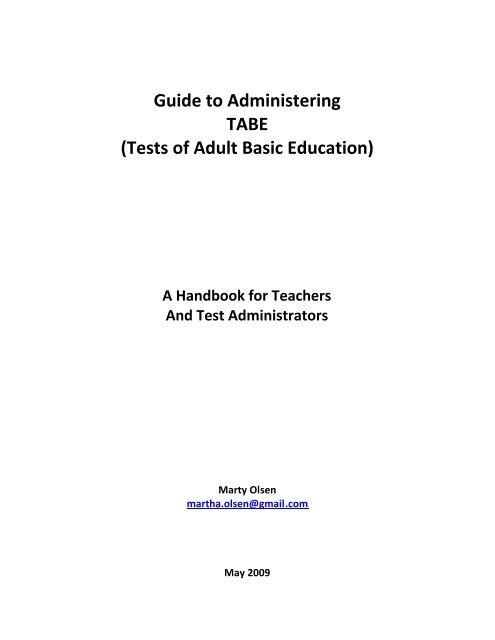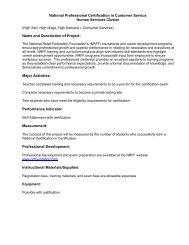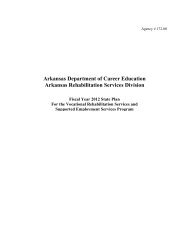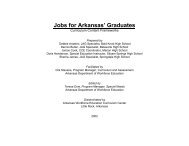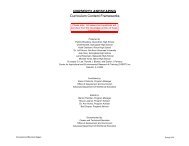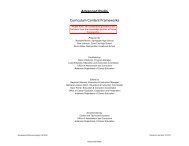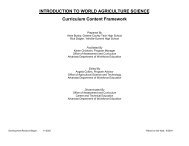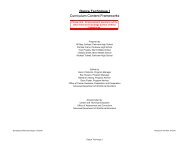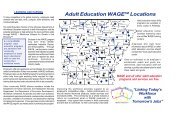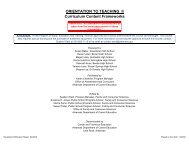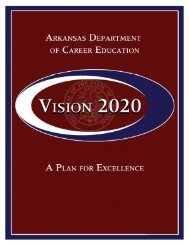Guide to Administering TABE - Arkansas Department of Career ...
Guide to Administering TABE - Arkansas Department of Career ...
Guide to Administering TABE - Arkansas Department of Career ...
You also want an ePaper? Increase the reach of your titles
YUMPU automatically turns print PDFs into web optimized ePapers that Google loves.
<strong>Guide</strong> <strong>to</strong> <strong>Administering</strong><br />
<strong>TABE</strong><br />
(Tests <strong>of</strong> Adult Basic Education)<br />
A Handbook for Teachers<br />
And Test Administra<strong>to</strong>rs<br />
Marty Olsen<br />
martha.olsen@gmail.com<br />
May 2009
TABLE OF CONTENTS<br />
<strong>Administering</strong> <strong>TABE</strong> (Tests <strong>of</strong> Adult Basic Education) ........................................................................................... 3<br />
Assessment.............................................................................................................................................. 3<br />
Placement................................................................................................................................................ 3<br />
Growth .................................................................................................................................................... 3<br />
Literacy Level ........................................................................................................................................... 3<br />
Prediction ................................................................................................................................................ 3<br />
Prescription ............................................................................................................................................. 3<br />
Appropriate Use <strong>of</strong> <strong>TABE</strong> 9 & 10 ............................................................................................................. 3<br />
<strong>TABE</strong> Assessment Instruments ............................................................................................................................. 4<br />
Practice and Loca<strong>to</strong>r Test ........................................................................................................................ 4<br />
<strong>TABE</strong> 9 & 10 Complete Battery ............................................................................................................... 4<br />
<strong>TABE</strong> 9 & 10 Survey ................................................................................................................................. 4<br />
Advanced Level Tests <strong>of</strong> Algebra/Geometry, Writing, Science and Social Studies ................................. 4<br />
<strong>TABE</strong> Tests for Students with Disabilities ................................................................................................ 4<br />
Testing Accommodations ........................................................................................................................ 5<br />
Registration, Intake and Placement at My Site ....................................................................................... 5<br />
<strong>Administering</strong> <strong>TABE</strong> – A Standardized Assessment .............................................................................................. 6<br />
<strong>Administering</strong> <strong>TABE</strong> for Low Literacy Learners ....................................................................................... 6<br />
Administration <strong>of</strong> the Word List ....................................................................................................... 6<br />
Administration <strong>of</strong> <strong>TABE</strong> 9 or 10 Level L Test..................................................................................... 7<br />
Scoring the <strong>TABE</strong> Level L ................................................................................................................... 7<br />
<strong>Administering</strong> the Word List, Level L and Loca<strong>to</strong>r at My Site........................................................... 7<br />
<strong>Administering</strong> <strong>TABE</strong> for All Other Learners ............................................................................................. 8<br />
<strong>Administering</strong> the Loca<strong>to</strong>r Test ........................................................................................................ 8<br />
Minneapolis ABE Suggested Pre-Test <strong>Guide</strong>lines ............................................................................. 8<br />
Pre-Test Item Count and Testing Times ........................................................................................... 9<br />
<strong>Administering</strong> the Loca<strong>to</strong>r and Pretests at My Site .......................................................................... 9<br />
Scoring the Pre-test ........................................................................................................................ 10<br />
NRS Educational Functioning Levels...................................................................................................... 10<br />
Placement <strong>of</strong> Students ........................................................................................................................................ 11<br />
Individual Diagnostic Pr<strong>of</strong>iles ................................................................................................................ 11<br />
GED Prediction ...................................................................................................................................... 12<br />
<strong>TABE</strong> and Technology ......................................................................................................................................... 12<br />
<strong>TABE</strong> TestMate for Windows ................................................................................................................ 12<br />
<strong>TABE</strong> PC ................................................................................................................................................. 12<br />
<strong>TABE</strong> Online ........................................................................................................................................... 12<br />
<strong>TABE</strong> Teaching Tools ........................................................................................................................................... 13<br />
Getting <strong>to</strong> Know <strong>TABE</strong> ........................................................................................................................... 13<br />
Preparing for the <strong>TABE</strong> .......................................................................................................................... 13<br />
Teacher’s <strong>Guide</strong> for Reading and Teacher’s <strong>Guide</strong> for Math ................................................................ 13<br />
Building Skills with <strong>TABE</strong> ....................................................................................................................... 13<br />
<strong>TABE</strong> Test Study <strong>Guide</strong> .......................................................................................................................... 13<br />
Academic Refresher .............................................................................................................................. 13<br />
McGraw-Hill Online Teaching Tools .................................................................................................................... 14<br />
Additional Links ................................................................................................................................................... 14<br />
Online Practice Tests........................................................................................................................................... 15<br />
Post-Testing <strong>Guide</strong>lines ...................................................................................................................................... 15<br />
CTB/McGraw-Hill Contacts ................................................................................................................................. 16<br />
Page | 2
ADMINISTERING <strong>TABE</strong> (Tests <strong>of</strong> Adult Basic Education)<br />
The <strong>TABE</strong> instruments provide assessment, placement, growth, literacy level, prediction, and<br />
prescription information.<br />
Assessment<br />
<strong>TABE</strong> 9 & 10 assessments are based on curriculum philosophies from adult education programs.<br />
The assessments come in two alternate forms, and five levels including L (Literacy), E (Easy), M<br />
(Medium), D (Difficult), and A (Advanced).<br />
Placement<br />
<strong>TABE</strong> 9 or 10, in addition <strong>to</strong> the Loca<strong>to</strong>r Test, can provide information for placement <strong>of</strong> students<br />
whose primary language is English.<br />
Growth<br />
To measure growth, all the 9 & 10 forms <strong>of</strong> the same level test are equated so that pre- and<br />
posttests will accurately measure gains <strong>of</strong> students.<br />
Literacy Level<br />
<strong>TABE</strong> 9 & 10 provides an assessment <strong>of</strong> the reading levels <strong>of</strong> literacy level students.<br />
Prediction<br />
<strong>TABE</strong> 9 & 10 scores provide a GED prediction score for each content area.<br />
Prescription<br />
The <strong>TABE</strong> group <strong>of</strong> assessment instruments provides lessons needed based on <strong>TABE</strong> scores.<br />
TestMate <strong>TABE</strong> Prescriptive Assignments can give au<strong>to</strong>matic reports <strong>of</strong> specific lessons the<br />
student needs, based on the <strong>TABE</strong> scores. With the computer scoring, group results for skills<br />
and content area are available <strong>to</strong> provide information for teachers for group instruction.<br />
Appropriate Use <strong>of</strong> <strong>TABE</strong> 9 & 10<br />
o English (first language) speakers entering ABE or GED classes<br />
o English Language Learners with CASAS scores <strong>of</strong> at least 236+<br />
o Not recommended for English Language Learners with CASAS scores below 236<br />
Page | 3
<strong>TABE</strong> ASSESSMENT INSTRUMENTS<br />
Practice and Loca<strong>to</strong>r Test<br />
The practice portion <strong>of</strong> the test helps students become familiar with the types <strong>of</strong> items on the<br />
test. The loca<strong>to</strong>r portion <strong>of</strong> the test helps <strong>to</strong> determine the appropriate test level <strong>of</strong> <strong>TABE</strong> 9 &<br />
10 for students. The Practice and Loca<strong>to</strong>r Test take approximately 55 minutes <strong>to</strong> administer.<br />
Beginning readers who cannot take the Practice and Loca<strong>to</strong>r Test can take the <strong>TABE</strong> Level L<br />
Test, Form 9 or 10.<br />
<strong>TABE</strong> 9 & 10 Complete Battery (recommended)<br />
The Complete Battery is a series <strong>of</strong> five tests at five levels that give both normed scores and skill<br />
and outcome-performance scores for adults. The Complete Battery includes Reading,<br />
Mathematics Computation, Applied Mathematics, Language, and Spelling. The Complete<br />
Battery takes approximately 3 hours <strong>to</strong> administer.<br />
<strong>TABE</strong> 9 & 10 Survey<br />
The Survey version includes Reading, Mathematics Computation, Applied Mathematics,<br />
Language, and Spelling. The Survey takes approximately 1.5 hours <strong>to</strong> administer, and also<br />
provides normed scores.<br />
Advanced-level tests <strong>of</strong> Algebra/Geometry, Writing, Science and Social Studies<br />
These optional tests diagnose needs that can be used <strong>to</strong> help prepare students for the<br />
GED. These tests are criterion-referenced, and focus on the subjects and level that help<br />
adult students see if they are ready <strong>to</strong> take the GED.<br />
These tests supplement the Reading, Language, Math, and Spelling tests <strong>of</strong>fered in <strong>TABE</strong><br />
9&10 Survey and Complete Battery.<br />
The Writing test provides two essay prompts published in two separate books. You gain<br />
the chance <strong>to</strong> pre- and post-test.<br />
The Science and Social Studies assessments are multiple-choice tests containing 35<br />
items each.<br />
The Algebra/Geometry test contains 60 selected-response items that reflect advanced<br />
math content.<br />
<strong>TABE</strong> Tests for Students with Disabilities<br />
<strong>TABE</strong> has:<br />
o Practice Exercises<br />
o Loca<strong>to</strong>r<br />
o Survey Form 9<br />
o Complete Battery Form 9<br />
Available in:<br />
o Large-print edition<br />
o Braille edition<br />
o Audio edition<br />
Page | 4
Testing Accommodations<br />
3 Categories <strong>of</strong> Accommodations:<br />
o Category 1 – does not affect the interpretation <strong>of</strong> the scores.<br />
• “take the test alone or in a study carrel”<br />
o Category 2 – may have an effect on student performance and should be considered<br />
when interpreting individual test scores<br />
• “use extra time for a timed test”<br />
o Category 3 – likely <strong>to</strong> change what is being measured and have an effect that alters the<br />
interpretation <strong>of</strong> individual scores<br />
• “use a calcula<strong>to</strong>r for a mathematics computation test”<br />
(More complete information can be found in the Test Directions on pages 11-13.)<br />
Registration, Intake and Placement at My Site<br />
1. Where do students go <strong>to</strong> register at your site?<br />
2. When can they register?<br />
3. What forms must be filled out at registration?<br />
4. When is the Loca<strong>to</strong>r Test given?<br />
5. Which Forms <strong>of</strong> <strong>TABE</strong> 9 & 10 do you use?<br />
6. Do you <strong>of</strong>fer Advanced Level Tests?<br />
7. Which tests do you have available for students with disabilities?<br />
8. What process do you follow if students requests accommodations?<br />
Page | 5
ADMINISTERING <strong>TABE</strong> – A Standardized Assessment<br />
All programs must administer and score the <strong>TABE</strong> tests exactly according <strong>to</strong> the test developer’s<br />
directions, in order <strong>to</strong> keep the process as consistent as possible across the state.<br />
Follow standardized testing procedures:<br />
Use proper timing<br />
Read script verbatim<br />
Follow test directions explicitly<br />
Do not review questions prior <strong>to</strong> testing<br />
Do not answer questions regarding test during testing<br />
Do not go over test with students after testing<br />
Ensure comparable testing situation for all examinees<br />
ADMINISTERING <strong>TABE</strong> FOR LOW LITERACY LEARNERS<br />
Very low literacy students may need <strong>to</strong> be assessed using the following process.<br />
Administration <strong>of</strong> the Word List<br />
Administration <strong>of</strong> the Word List (directions found on page 17) takes about 15 minutes (per<br />
person) and <strong>TABE</strong> Level L Reading takes about 50 minutes. First, administer the Word list, which<br />
will indicate whether <strong>to</strong> administer the <strong>TABE</strong> Level L or the Loca<strong>to</strong>r Test (which takes 35<br />
minutes). Use the following guidelines for scoring the Word List:<br />
• If learner incorrectly reads or skips three words in a row, have the learner s<strong>to</strong>p and then<br />
administer the <strong>TABE</strong> Level L Test Booklet.<br />
• If learner incorrectly reads or skips five or more words on the entire list, administer the<br />
<strong>TABE</strong> Level L Test Booklet.<br />
• If learner incorrectly reads or skips no more than four words on the entire list,<br />
administer the Loca<strong>to</strong>r Test.<br />
Additional Word List administration and scoring information from the test publisher:<br />
• Test administra<strong>to</strong>rs may not deviate from the script or test directions in any way.<br />
• It is permissible <strong>to</strong> have an examinee repeat a word if the administra<strong>to</strong>r did not hear the<br />
reply clearly.<br />
• If a non-native English speaking examinee can read the word, and the test administra<strong>to</strong>r<br />
can understand the word, regardless <strong>of</strong> accent, it is marked correct. Test administra<strong>to</strong>rs<br />
must be careful not <strong>to</strong> “fill in,” or assume he/she “knew what the examinee meant.”<br />
• If an examinee needs <strong>to</strong> sound out a word but does so accurately, the word may be<br />
marked as correct.<br />
• If an examinee is struggling early on and has five words wrong early in the test, s<strong>to</strong>p the<br />
Word List.<br />
• The Word list columns may be covered and words pointed <strong>to</strong>. Do not cut up the Word<br />
list in<strong>to</strong> separate columns.<br />
Page | 6
Administration <strong>of</strong> Form 9 or 10 <strong>TABE</strong> Level L Test<br />
If indicated, administer the Form 9 or 10 <strong>TABE</strong> Level L Test. The directions for <strong>TABE</strong> Form 9<br />
Level L are found on page 35 in the test directions, <strong>TABE</strong> Form 10, Level L directions are found<br />
on page 59. These forms contain two tests each that assess Pre-reading Skills (e.g., matching<br />
letters, recognizing letters, beginning, ending and middle sounds) and reading Skills (e.g.,<br />
recognizing signs and symbols, word meaning, context meaning, phrase/sentence meaning, and<br />
passage meaning). This section <strong>of</strong> the test may be administered <strong>to</strong> a group orally while<br />
examinees select answers from their individual test booklets. A short break may be given<br />
between the Pre-Reading and Reading Skills tests, but do not administer them in two separate<br />
testing sessions.<br />
Scoring the <strong>TABE</strong> Level L<br />
1. Total the number <strong>of</strong> correct responses from the learner’s Level L test Booklet.<br />
2. Any test item that has more than one answer marked, with no answer crossed out, may<br />
not be counted.<br />
3. Both the Pre-Reading Skills and the Reading Skills must be administered, but only the<br />
Reading Skills Number Correct score will be used <strong>to</strong> determine the learner’s scale score.<br />
4. Using the <strong>TABE</strong> Norms Book for Forms 9/10, locate the appropriate table for the test<br />
form (either 9 or 10) for the Reading Skills Test. Form 9 is on page 9 <strong>of</strong> the Norms Book,<br />
and Form 10 is on page 93.<br />
5. Match the student’s <strong>to</strong>tal correct answers with the corresponding number in the NC<br />
(Number Correct) column in the Norms Book.<br />
6. The column marked SS <strong>to</strong> its right indicates the Scale Score for that Number Correct.<br />
7. The column marked GE indicates the Grade Level Equivalent for that score.<br />
8. When using the Level L in pre-testing, note the number correct, and consider if there is<br />
enough room for a learner <strong>to</strong> show gain in the fiscal year. For example, if a learner<br />
scores a 25 or 26 out <strong>of</strong> 27 correct, it may be more advantageous <strong>to</strong> have a learner try a<br />
Level E test.<br />
<strong>Administering</strong> the Word List, Level L and Loca<strong>to</strong>r at My Site<br />
1. Where are the <strong>TABE</strong> assessments and testing supplies s<strong>to</strong>red?<br />
2. Who decides when a Word List and/or Level L assessment are appropriate?<br />
3. Who is responsible for administering the Word List and Level L?<br />
Page | 7
ADMINISTERING <strong>TABE</strong> FOR ALL OTHER LEARNERS<br />
<strong>Administering</strong> the Loca<strong>to</strong>r Test<br />
1. Have students complete demographics information as required by your program.<br />
2. Administer the Loca<strong>to</strong>r test, following the script in the administration booklet.<br />
Test- Administra<strong>to</strong>r Script Page<br />
Survey or Complete Battery Test Directions<br />
Loca<strong>to</strong>r Test<br />
# <strong>of</strong> items Testing Time<br />
(h:m)<br />
Reading – page 23 12 0:12<br />
Mathematics Computation – page 25 8 0:05<br />
Applied Mathematics – page 27 8 0:08<br />
Language – page 28 12 0:12<br />
TOTAL 40 0:37<br />
3. Score the Loca<strong>to</strong>r test <strong>to</strong> determine the correct level <strong>of</strong> pre-test. Use the chart found on<br />
page 32 <strong>of</strong> the Test Directions. (**Based on experience, Minneapolis ABE has set more<br />
stringent guidelines for pre-test determination – see chart below.)<br />
4. Administer the pre-tests, following the script in the administration booklet.<br />
5. Score the pre-tests <strong>to</strong> determine class placement.<br />
**MINNEAPOLIS ABE SUGGESTED PRE-TEST GUIDELINES<br />
(Based on Loca<strong>to</strong>r Test Results)<br />
Reading ** Mathematics Language <strong>TABE</strong> Level<br />
0-1 L<br />
2-6 4-6 6 and<br />
below<br />
7-8 7-8 7-8 M<br />
9-11 (used full 12 minutes) M<br />
9-11 (completed test<br />
quickly)<br />
12 (used full 12 minutes) 9-11 9-10 D<br />
12 (completed test quickly) 12-16 11-12 A<br />
E<br />
D<br />
Page | 8
Pre-Test Item Count and Testing Times<br />
Allow time for instructions, recording names on answer sheets, etc.<br />
Survey<br />
Complete Battery<br />
Test # <strong>of</strong> Items Testing Time<br />
(h:m)<br />
# <strong>of</strong> Items Testing Time<br />
(h:m)<br />
Reading 25 0:25 50 0:50<br />
Math<br />
Computation<br />
25 0:15 40 0:24<br />
Applied Math 25 0:25 50 0:50<br />
Language 25 0:25 55 0:55<br />
TOTAL 100 1:30 195 2:59<br />
Optional tests<br />
(Vocabulary, Language Mechanics, and Spelling)<br />
Shown in this separate table as they do not contribute <strong>to</strong> the <strong>to</strong>tal score.<br />
Test # <strong>of</strong> Items Testing Time<br />
(h:m)<br />
Vocabulary 20 0:14<br />
Language Mechanics 20 0:14<br />
Spelling 20 0:10<br />
TOTAL 60 0:38<br />
<strong>Administering</strong> the Loca<strong>to</strong>r and Pretests at My Site<br />
1. Who administers the Loca<strong>to</strong>r?<br />
2. Who corrects the Loca<strong>to</strong>r and determines the proper level <strong>of</strong> pretest <strong>to</strong> administer?<br />
3. Do you have any additional orientation procedures <strong>to</strong> follow?<br />
4. Do you complete any goal-setting activities with your students?<br />
Page | 9
Scoring the Pre-test<br />
1. After the learner has completed the test, or at the end <strong>of</strong> the maximum testing time,<br />
collect all test booklets and answer sheets.<br />
a. Check each answer sheet <strong>to</strong> be sure there is a name written on it.<br />
b. Review each test <strong>to</strong> be sure only one answer is marked for each question. (If<br />
not, the answer is marked incorrect.)<br />
2. Match the appropriate scoring transparency test form and level <strong>to</strong> the answer sheet and<br />
determine how many answers are correct.<br />
3. Refer <strong>to</strong> the score conversion chart in the Norms Book <strong>to</strong> find the correct test form and<br />
test level column. Find the Number Correct (NC) and look <strong>to</strong> the right for the Scaled<br />
Score (SS).<br />
4. Pay attention <strong>to</strong> the Standard Error <strong>of</strong> Measurement (SEM) – a high SEM may indicate<br />
that that the test level was incorrect.<br />
5. The Scaled Score is correlated <strong>to</strong> the NRS Educational Functioning Levels.<br />
6. If required by your program, the Grade Equivalent (GE) is also found on the same<br />
conversion chart.<br />
NRS (National Reporting System)<br />
Educational Functioning Levels<br />
CASAS<br />
Scaled Score<br />
ABE/GED Educational<br />
Functioning Levels<br />
<strong>TABE</strong><br />
Scaled Score<br />
<strong>TABE</strong> Score<br />
Grade Level<br />
Reading 0 – 200<br />
Math 0 – 200<br />
Writing 0 – 200<br />
Reading 201 – 210<br />
Math 201 – 210<br />
Writing 201 – 225<br />
Reading 211 – 220<br />
Math 211 – 220<br />
Writing 226 – 242<br />
Reading 221 – 235<br />
Math 221 – 235<br />
Writing 243 – 260<br />
Reading 236 – 245<br />
Math 236 – 245<br />
Writing 261 - 270<br />
Reading 246 & up<br />
Math 246 & up<br />
Writing 271 & up<br />
Beginning ABE Literacy Reading 0 – 367<br />
Math 0 – 313<br />
Language 0 – 392<br />
Beginning ABE Reading 368 – 460<br />
Math 314 – 441<br />
Language 393 – 490<br />
Low Intermediate ABE Reading 461 – 517<br />
Math 442 – 505<br />
Language 491 – 523<br />
High Intermediate ABE Reading 518 – 566<br />
Math 506 – 565<br />
Language 524 – 559<br />
Low Adult Secondary Reading 567 – 595<br />
Math 566 – 594<br />
Language 560 – 585<br />
High Adult Secondary Reading 596+<br />
Math 595+<br />
Language 586 & up<br />
0 – 1.9<br />
2 – 3.9<br />
4 – 5.9<br />
6 – 8.9<br />
9 – 10.9<br />
11 – 12.9<br />
Page | 10
PLACEMENT OF STUDENTS<br />
Each level <strong>of</strong> the <strong>TABE</strong> is designed <strong>to</strong> measure a different grade level content range.<br />
Test Level<br />
Grade Range<br />
L (Literacy) 0 – 1.9<br />
E (Easy) 2.0 – 3.9<br />
M (Medium) 4.0 – 5.9<br />
D (Difficult) 6.0 – 8.9<br />
A (Advanced) 9.0 – 12.9<br />
Placement Considerations:<br />
Situation #1: A new learner scores 524 (6.2) on a Level E Reading test.<br />
o What does this score mean?<br />
o What do you know about the Level E test?<br />
o What recommendation would you make?<br />
Situation #2: A new learner scores 567 (9.0) on a Level M Reading test.<br />
o What does this score mean?<br />
o What do you know about the Level M test?<br />
o What recommendation would you make?<br />
Individual Diagnostic Pr<strong>of</strong>iles (IDPs)<br />
The Individual Diagnostic Pr<strong>of</strong>ile lists objectives and skills measured by the tests, and provides<br />
spaces for indicating mastery or non-mastery. The IDP presents information on levels <strong>of</strong> test<br />
performance based on the number correct and mastery summaries.<br />
Page | 11
GED Prediction<br />
A study was done <strong>to</strong> determine the relationship between <strong>TABE</strong> and GED 2002 with the<br />
following results (sampling only - a full chart can be found in the back <strong>of</strong> your Norms Book).<br />
Modality <strong>TABE</strong> GED<br />
Reading 576-588 410<br />
Reading 629-642 450<br />
Reading 696-708 500<br />
Math 587-600 410<br />
Math 645-658 450<br />
Math 718-731 500<br />
<strong>TABE</strong> AND TECHNOLOGY<br />
o <strong>TABE</strong> TestMate for Windows will score the tests, generate competency-based skills pr<strong>of</strong>iles,<br />
showing individual strengths and weaknesses, and has the capability <strong>of</strong> providing<br />
“prescriptions” that direct students <strong>to</strong> specific materials they should study.<br />
o <strong>TABE</strong> PC provides au<strong>to</strong>mated administration, scoring and utilizes diagnostic information<br />
that provides a pr<strong>of</strong>ile <strong>of</strong> each student's strong and weak skills through an individual<br />
computer or network.<br />
o <strong>TABE</strong>-Online provides a way <strong>to</strong> register students, then administer tests <strong>to</strong> a single student<br />
or an entire group. The assessments are scored au<strong>to</strong>matically and reports generated<br />
immediately, providing a clear understanding <strong>of</strong> skills levels and instructional needs.<br />
Page | 12
<strong>TABE</strong> TEACHING TOOLS<br />
Getting <strong>to</strong> Know <strong>TABE</strong><br />
This is an introduc<strong>to</strong>ry workbook that is designed <strong>to</strong> familiarize students with standardized<br />
testing.<br />
• User-friendly text (easy <strong>to</strong> medium level content)<br />
• Coverage <strong>of</strong> all five subject areas assessed by <strong>TABE</strong>—reading, mathematics<br />
computation, applied mathematics, language and spelling<br />
• Upbeat, first-person s<strong>to</strong>ries from successful adult students<br />
• Practice items <strong>to</strong> familiarize students with multiple-choice items and <strong>to</strong> provide<br />
experiences on “bubble in” answer grids<br />
Preparing for the <strong>TABE</strong><br />
http://www.fldoe.org/workforce/pdf/<strong>TABE</strong>_book4web.pdf<br />
This is a free, downloadable book created by the Florida <strong>Department</strong> <strong>of</strong> Education. It is<br />
patterned after the “Getting <strong>to</strong> Know <strong>TABE</strong>” book.<br />
Teacher’s <strong>Guide</strong> for Reading and Teacher’s <strong>Guide</strong> for Mathematics<br />
These guides contain instructional techniques, strategies, and classroom activities and<br />
worksheets designed <strong>to</strong> address the item types on the <strong>TABE</strong> assessments.<br />
Building Skills with <strong>TABE</strong><br />
This is a series <strong>of</strong> eight student workbooks that address the four highest levels <strong>of</strong> <strong>TABE</strong> – EASY,<br />
MEDIUM, DIFFICULT, and ADVANCED – two workbooks for each level. One workbook covers<br />
Reading, Language and Spelling, the other covers Mathematics Computation and Applied<br />
Mathematics. Each book includes:<br />
• Explanation <strong>of</strong> how <strong>to</strong> build each basic skill<br />
• Poetry and drama content in the Reading section (Level A) <strong>to</strong> coincide with GED content<br />
• Practice items<br />
• Examples <strong>of</strong> real-life applications <strong>of</strong> skills<br />
• Test-taking and learning tips<br />
<strong>TABE</strong> Test Study <strong>Guide</strong><br />
http://www.studyguidezone.com/pdfs/tabeteststudyguide.pdf<br />
This 49-page booklet includes test-taking strategies and hints for the Reading, Mathematics and<br />
Language portions <strong>of</strong> the <strong>TABE</strong> test.<br />
Academic Refresher<br />
http://www.fireacademy.org/PDF_Files/<strong>TABE</strong>_refresher.pdf<br />
This packet may be used as a brush-up in preparation for basic academic testing. It contains<br />
samples <strong>of</strong> math problems and English usage rules. It is designed as a quick review for persons<br />
who learned the material but may not have used it in years. It is not intended <strong>to</strong> teach new<br />
information. A few rules <strong>of</strong> algebra and mathematical formulas have been included.<br />
Page | 13
McGraw-Hill Online Teaching Tools<br />
The following links lead <strong>to</strong> online activities designed as additional instruction and practice <strong>to</strong> be<br />
used with Contemporary’s GED series.<br />
McGraw-Hill Online Learning Center (Writing)<br />
http://highered.mcgraw-hill.com/sites/0809222280/<br />
McGraw-Hill Online Learning Center (Reading)<br />
http://highered.mcgraw-hill.com/sites/0809222310/<br />
McGraw-Hill Online Learning Center (Social Studies)<br />
http://highered.mcgraw-hill.com/sites/0809222299/<br />
McGraw-Hill Online Learning Center (Science)<br />
http://highered.mcgraw-hill.com/sites/0809222302/<br />
McGraw-Hill Online Learning Center (Math)<br />
http://highered.mcgraw-hill.com/sites/0809222329/<br />
Additional Links<br />
Language – Writing:<br />
Essay Punch (Language Arts, Writing – essay)<br />
http://www.essaypunch.com/<br />
Grammar Bytes (Language Arts, Writing – grammar)<br />
http://www.chompchomp.com/menu.htm<br />
<strong>Guide</strong> <strong>to</strong> Grammar & Writing (Language Arts, Writing)<br />
http://grammar.ccc.commnet.edu/grammar/<br />
OWL Online Writing Lab (Language Arts, Writing)<br />
http://owl.english.purdue.edu/handouts/grammar/<br />
Reading:<br />
California Distance Learning Project (Language Arts, Reading)<br />
http://www.cdlponline.org/<br />
Literacy Resources ((Language Arts, Reading)<br />
http://www.literacynet.org/cnnsf/<br />
Reading Comprehension Connection (Language Arts, Reading)<br />
http://www.readingcomprehensionconnection.com/<br />
Mathematics:<br />
AAA Math (Mathematics)<br />
http://www.aaamath.com/B/lmpg.htm<br />
Aplus Math (Mathematics)<br />
http://aplusmath.com/<br />
Math Goodies (Mathematics)<br />
http://mathgoodies.com/<br />
Simple Fractions (Mathematics)<br />
http://www.sosmath.com/algebra/fraction/frac3/frac3.html<br />
Page | 14
Online Practice Tests<br />
Test Prep Review – <strong>TABE</strong> Online Course<br />
http://www.testprepreview.com/tabe_practice.htm (Practice Questions - printable)<br />
http://www.testprepreview.com/tabelinks.htm (Skill Improvement Links)<br />
The following practice tests are for upper level students. There is no scoring rubric, but<br />
looking at the missed items will indicate areas for study. They can be printed.<br />
Practice Reading Test<br />
http://www.fireacademy.org/PDF_Files/<strong>TABE</strong>_reading.pdf<br />
Practice Language Test<br />
http://www.fireacademy.org/PDF_Files/<strong>TABE</strong>_language.pdf<br />
Math Practice Test<br />
http://www.fireacademy.org/PDF_Files/<strong>TABE</strong>_math.pdf<br />
Steck-Vaughn’s GED Practice<br />
http://www.gedpractice.com<br />
This is a free service provided by Steck-Vaughn <strong>to</strong> familiarize students with the types <strong>of</strong><br />
items they will see on the actual GED test. The tests are completed online. By answering<br />
GED practice questions and getting feedback, they will develop a feel for the kind <strong>of</strong><br />
reading, thinking, and problem-solving skills they will need <strong>to</strong> pass the GED test.<br />
Post-testing <strong>Guide</strong>lines<br />
1. If a student’s pre-test was in the mid-range <strong>of</strong> a level, it would be best <strong>to</strong> post-test them<br />
with an alternate form <strong>of</strong> the same level; however, a high range score on the pre-test, or<br />
extraordinary progress in the classroom may indicate that they should post-test with the<br />
next level.<br />
2. If you are unsure as <strong>to</strong> which level <strong>of</strong> post-test <strong>to</strong> administer, you may readminister the<br />
Loca<strong>to</strong>r Test <strong>to</strong> determine appropriate level for post-testing.<br />
3. Because all levels <strong>of</strong> <strong>TABE</strong> are calibrated on the same scale, results may be compared<br />
across levels.<br />
Situation #1: A learner scores 542 (7.4) on a Level M Reading test.<br />
o Should his/her posttest be with an M or a D Level test?<br />
o Note on reading passages:<br />
• The reading passages increase in length and difficulty between the levels, so it is not<br />
uncommon that a slight drop in scores may occur with the first test at the higher level.<br />
If you give the higher level test <strong>to</strong>o early, however, a much more significant drop in<br />
scores (as much as two or more GE) is likely <strong>to</strong> result.<br />
• It is also important <strong>to</strong> keep in mind the grade level content range <strong>of</strong> class<br />
instruction.<br />
Situation #2: A learner gets a 513 (5.8) on a D level test.<br />
o Should his/her posttest be with a D or an M level test?<br />
Page | 15
True or False<br />
1. <strong>TABE</strong> 9 and 10 is suitable for adult students who read below the ninth-grade level.<br />
(True)<br />
2. You can administer Easy, Medium, Difficult, and Advanced level tests at the same time<br />
at the same site. (True)<br />
3. You should not use the Loca<strong>to</strong>r Test <strong>to</strong> screen students for placement in<strong>to</strong> educational<br />
programs. (True)<br />
4. All examinees must take the tests under the exact same conditions. (False)<br />
5. Testing accommodations for disabled students are required by law. (True)<br />
6. A student should be allowed any accommodation he or she wants <strong>to</strong> use. (False)<br />
7. Sometimes it is OK <strong>to</strong> show an examinee a few test questions before an assessment<br />
actually starts. (False)<br />
8. Test administra<strong>to</strong>rs should never let examinees take breaks during the administration <strong>of</strong><br />
a <strong>TABE</strong> test. (False – not in the middle <strong>of</strong> a test, but between tests is OK)<br />
CTB/McGraw-Hill Contacts<br />
www.ctb.com (then click on Adult Education)<br />
Evaluation Consultant<br />
Stephen Marsh (Minnesota)<br />
Evaluation Consultant<br />
Tel: (608) 825-7999<br />
E-mail: stephen_marsh@ctb.com<br />
For Help Specifying and Placing Orders:<br />
Cus<strong>to</strong>mer Services Representatives<br />
are available 6:00 AM <strong>to</strong> 5:00 PM,<br />
Pacific Time.<br />
Tel: 800.538.9547<br />
Fax: 800.282.0266<br />
TDD: 800.217.9190<br />
For Help with Scoring Services:<br />
Contact the CTB Scoring Services <strong>of</strong>fice<br />
Tel: 800.282.7267 (800.CTB.SCOR)<br />
Fax: 800.428.2329<br />
For Help with CTB S<strong>of</strong>tware:<br />
The CTB Technical Support staff is available<br />
4:30 AM <strong>to</strong> 5:00 PM, Pacific Time.<br />
Tel: 800.459.6522<br />
Fax: 800.459.4210<br />
E-mail: tmsupport@ctb.com<br />
Page | 16


